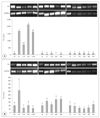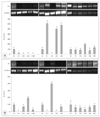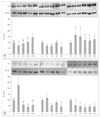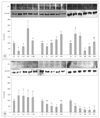Abstract
Collagen is the major matrix protein in dermis and consists of proline and lysine, which are hydroxylated by prolyl hydroxylase (PH) and lysyl hydroxylase (LH) with cofactors such as vitamin C, oxygen, iron (Fe2+), ketoglutarate and silicon. The collagen degradation is regulated by matrix metalloproteinase-1 (MMP-1), of which is the major collagen-degrading proteinase whereas tissue inhibitors of metalloproteinase-1 (TIMP-1) bind to MMP-1 thereby inhibiting MMP-1 activity. In this study, we investigated the effects of vitamin C, silicon and iron on mRNA, protein expressions of PH, LH, MMP-1 and TIMP-1. The physiological concentrations of vitamin C (0-100 µM), silicon (0-50 µM) and iron (Fe2+:0-50 µM) were treated to human dermal fibroblast cells (HS27 cells) for 3 or 5days. The expression level of mRNA and protein was increased in not only PH but also LH when cells were incubated with vitamin C. A similar increase in LH mRNA or protein expression occurred when cells were incubated with silicon. Our results suggest that treatment of vitamin C and silicon increased mRNA and protein expression of PH and LH in human dermal fibroblast.
Figures and Tables
Fig. 1
Effects of ascorbic acid, silicon and iron on prolyl hydroxylase (PH) mRNA expressions of cultured human dermal fibroblasts. Human dermal fibroblast cultures were treated with ascorbic acid (0, 5, 10, 50, 100 µM), silicon (0, 5, 10, 25, 50 µM) and Fe (0, 5, 10, 20, 30, 50, 100 µM) for 3 days (A) and 5 days (B). The expression levels of PH mRNA was analyzed by RT-PCR. The signal intensity were quantified the integrated area were percentized to the signal observed in control cells (% control). Results shown are means ± SEM (n = 3)(p < 0.05).

Fig. 2
Effects of ascorbic acid, silicon and iron on lysyl hydroxylase (LH) mRNA expressions of cultured human dermal fibroblasts. Human dermal fibroblast cultures were treated with ascorbic acid (0, 5, 10, 50, 100 µM), silicon (0, 5, 10, 25, 50 µM) and Fe (0, 5, 10, 20, 30, 50, 100 µM) for 3 days (A) and 5 days (B). The expression levels of LH mRNA was analyzed by RT-PCR. The signal intensity were quantified the integrated area were percentized to the signal observed in control cells (% control). Results shown are means ± SEM (n = 3)(p < 0.05).

Fig. 3
Effects of ascorbic acid, silicon and iron on prolyl hydroxylase (PH) protein expressions of cultured human dermal fibroblasts. Human dermal fibroblast cultures were treated with ascorbic acid (0, 5, 10, 50, 100 µM), silicon (0, 5, 10, 25, 50 µM) and Fe (0, 5, 10, 20, 30, 50, 100 µM) for 3 days (A) and 5 days (B). The expression levels of PH proteins was analyzed by western blotting. The signal intensity were quantified the integrated area were percentized to the signal observed in control cells (% control). Results shown are means ± SEM (n = 3)(p < 0.05).

Fig. 4
Effects of ascorbic acid, silicon and iron on Lysyl hydroxylase (LH) protein expressions of cultured human dermal fibroblasts. Human dermal fibroblast cultures were treated with ascorbic acid (0, 5, 10, 50, 100 µM), silicon (0, 5, 10, 25, 50 µM) and Fe (0, 5, 10, 20, 30, 50, 100 µM) for 3 days (A) and 5 days (B). The expression levels of LH proteins was analyzed by western blotting. The signal intensity were quantified the integrated area were percentized to the signal observed in control cells (% control). Results shown are means ± SEM (n = 3)(p < 0.05).

Fig. 5
Effects of ascorbic acid, silicon and iron on MMP-1 and TIMP-1 expressions of cultured human dermal fibroblasts. Human dermal fibroblast cultures were treated with ascorbic acid (0, 5, 10, 50, 100 µM), silicon (0, 5, 10, 25, 50 µM) and Fe (0, 5, 10, 20, 30, 50 µM) for 3 days. A: The expressions of MMP-1 protein was analysis by western blotting. B: The expressions of TIMP-1 was analyzed by western blotting. Results shown are means ± SEM.

References
1. Kim NM, Koo BS, Lee SK, Hwang EI, So SH, Do JH. Effect of Korean red ginseng on collagen biosynthesis and MMP-I activity in human dermal fibroablast. J Ginseng Res. 2007. 31(2):86–92.
2. Matsumura Y, Ananthaswamy HN. Toxic effects of ultraviolet radiation on the skin. Toxicol Appl Pharmacol. 2004. 195:298–308.

3. Fisher GJ, Kang S, Varani J, Bata-Csorgo Z, Wan Y, Datta S, Bpprjees JJ. Mechanisms of photoaging and chronological skin againg. Arch Dermatol. 2002. 138:1462–1470.
4. Elsner P, Wilhelm D, Maibach HI. Mechanical properties of human forearm and vulvar skin. Br J Dermatol. 1990. 122:607–614.

5. Prockop DJ, Berg RA, Kivirikko KI, Uitto J. Ramachandran GN, Reddi AH, editors. Intracellular steps in the biosynthesis of collagen, Biochemistry of Collagen. 1976. New York: Plenum Press;163–273.
6. Jemec G, Jemec B, Jemec BIE. The effect of superficial hydration the mechanical properties of human skin in vivo. Plast Reconstr Surg. 1990. 85:100–103.

7. Pinnell SR, Murad S, Darr D. Induction of collagen synthesis by ascorbic acid. A possible Mechanism. Arch Dermatol. 1987. 123:1684–1686.

8. Passoja K, Rautavuoma K, Ala-Kokko L, Kosonen T, Kivirikko KI. Cloning and characterization of a third human lysyl hydroxylase isoform. Proc Natl Acad Sci USA. 1998. 95(18):10482–10486.

9. Seaborn CD, Nielsen FH. Silicon deprivation decreases collagen formation in wounds and bone, and ornithine transaminase enzyme activity in liver. Biol Trace Elem. 2002. 89(3):251–261.

10. Wlaschek M, Tantcheva-Poór I, Naderi L, Ma W, Schneider LA, Razi-Wolf Z, Schüller J, Scharffetter-Kochanek K. Solar UV irradiation and dermal photoaging. J Photochem Photobio. 2001. 63(1-3):41–51.

11. Fisher GJ, Kang SW, Voorhees JJ. Retinoic acid inhibits induction of c-Jun protein by ultraviolet radiation that occur subsequent to activation of mitogen-activated protein kinase pathways in human skin in vivo. J Clin Invest. 1998. 101(6):1432–1440.

12. Enjoji M, Kotoh K, Iwamoto H, Nakamuta M, Nawata H. Self-regulation of Type I collagen degradation by collagen-induced production of matrix metalloproteinase-1 on cholangiocarcinoma and hepatocellular carcinoma cells. In vitro Cell Dev Biol Anim. 2000. 36:71–73.

13. Fisher GJ, Voorhees JJ. Molecular mechanism of photoaging in human skin in vivo and their prevention by all-trans retinoic acid. Photochem Photobiol. 1999. 69(2):154–157.

14. Tajima S, Pinnel SR. Ascorbic acid preferentially enhances type I and III collagen gene transcription in human skin fibroblasts. J Dermatol Sci. 1996. 11:250–253.

15. Carlisle EM. Silicon: a requirement in bone formation independent of vitamin D. Calcif Tissue Int. 1981. 33:27–34.

16. Che P, Xu J, Shi H, Ma Y. Quantitative determination of serum iron in human blood by high-performance capillary electrophoresis. J Chromatogr B Biomed Sci Appl. 1995. 669:45–51.

17. Fähling M, Perlewitz A, Doller A, Thiele BJ. Thiele. Regulation of collagen prolyl 4-hydroxylase and matrix metalloproteinases in fibrosarcoma cells by hypoxia. Comp Biochem Physiol Part C. 2004. 139:119–126.

18. Uzawa K, Grzesik WJ, Nishiura T, Kuznetsov SA, Robey PG, Brenner DA, Yamauchi M. Differential expression of human lysyl hydroxylase genes, lysine hydroxylation, and cross-linking of type I collagen during osteoblastic differentiation in vitro. J Bone Miner Res. 1999. 14(8):1272–1280.

19. Sim GS, Kim JH, Lee DH, Park SM, Pyo HB, Zhang YH, Lee BC. Effects of the Spatholobi Caulis extract on Antioxidation and inhibition of Matrix Metalloproteinase in Human Skin Fibroblasts. Korean J Biochnol Bioeng. 2005. 20(1):40–45.
20. Murad S, Sivarajah A, Pinnell SR. Prolyl and lysyl hydroxylase activities of human skin fibroblast: effect of donor age and ascorbate. J Invest Dermatol. 1980. 75:404–407.

21. Ronni C. Micronutrient requirements in older women. Am J Clin Nutr. 2005. 81:1240–1245.
22. Murad S, Tajima S, Johnson GR, Sivarajah S, Pinnell SR. Collagen synthesis in cultured human skin fibroblasts: Effect of ascorbic acid and its analogs. J Invest Dermatol. 1983. 81:158–162.

23. Boyera N, Galey I, Bernard BA. Effect of vitamin C and its derivatives on collagen synthesis and cross-linking by normal human fibroblasts. Int J Cosmet Sci. 1998. 20:151–158.

24. Duarte TL, Almeida GM, Jones GD. Investigation of the role of extracellular H2O2 and transition metal ions in the genotoxic action of ascorbic acid in cell culture models. Toxicol Lett. 2007. 170(1):57–65.

25. Campo GM, Avenoso A, Campo S, D'Ascola A, Ferlazzo AM, Samà D, Calatroni A. Purified human chondroitin-4-sulfate reduced MMP/TIMP imbalance induced by iron plus ascorbate in human fibroblast cultures. Cell Biol Int. 2006. 30(1):21–30.

26. Barel A, Calomme M, Timchenko A, De Paepe K, Demeester N, Rogiers V, Clarys P, Vanden Berghe D. Effect of oral intake of choline-stabilized orthosilicic acid on skin, nails and hair in women with photodamaged skin. Arch Dermatol Res. 2005. 297(4):147–153.

27. Ma XB, Sun SX, Yang F. Effect of human silicotic alveolar macrophages on the expression of matrix metalloproteinase-1 and tissue inhibitor of metalloproteinases-1 in human lung fibroblasts. Zhonghua Lao Dong Wei Sheng Zhi Ye Bing Za Zhi. 2004. 22(5):358–360.
28. Tuderman L, Myllo R, Kivirikko KI. Mechanism of the prolyl hydroxylase reaction. I. Role of co-substrates. Eur J Biochem. 1977. 80:341–348.

29. Switzer BR, Summer GK. Collagen synthesis in human skin fibroblasts: effects of ascorbate, α-ketoglutarate and ferrous ion on proline hydroxylation. J Nutr. 1972. 102(6):721–728.

30. Oono T, Shirafuji Y, Huh WK, Akiyama H, Iwatsuki K. Effects of human neutrophil peptide-1 on the expression of interstitial collagenase and type I collagen in human dermal fibroblasts. Arch Dermatol Res. 2002. 294:185–189.





 PDF
PDF ePub
ePub Citation
Citation Print
Print



 XML Download
XML Download